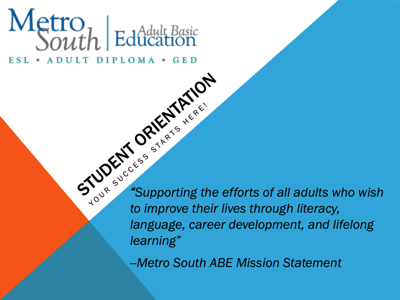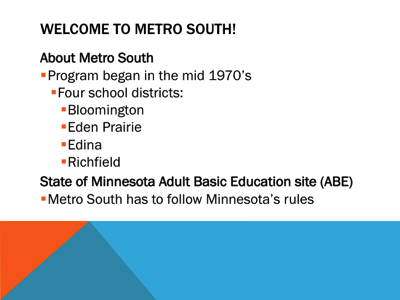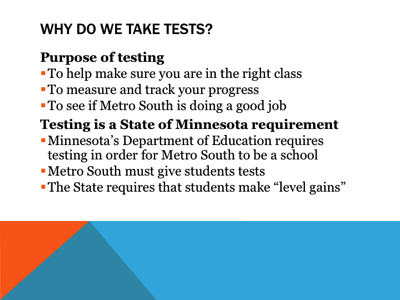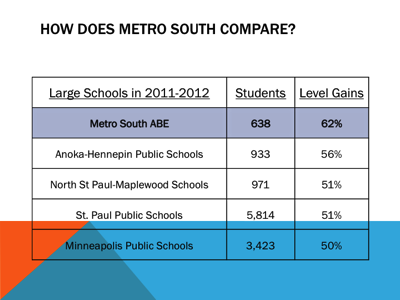Communication: New Student Orientation Presentation
The Opportunity: In 2010, Metro South ABE changed from an open-enrollment model to a managed-enrollment model. Previously, new students were able to join our classes whenever they might like. Managed-enrollment came with a switch to a five-term calendar model, with all new students starting only at the beginning of the five academic terms. This reduced the chaos happening in our classrooms and allowed teachers and students to predictably move forward together for a set amount of time. As students advanced in their studies, they also joined new classes only at the beginning of each term.
This created the opportunity to address a long-term problem. Students joined our program and had no formal introduction to how our program worked, how they could progress more quickly, and what opportunities were available to them. We also had a somewhat informal set of school norms. In the spring of 2012, our volunteer coordinator and I decided to begin correcting these issues.
The Team: We new we needed significant input, support, and investment from a wide variety of staff members. We first spoke with our director, who encouraged us to form a workgroup to address the issue. We gathered our two ESL teachers, our registration team, and some front-office staff members. This group provided us with a variety of perspectives and the information we needed to design this process.
Our first meetings centered around when we would do our orientation: At registration, in a special class for new students, or in the classrooms with all students.
I was an advocate for having teachers present the information at the beginning of each term in their classroom, for all students. This allowed for clear, consistent, repeated communication. Each student was at a different place in their journey, and could benefit from reviewing the many opportunities available to them. We eventually settled on this approach, and created a PowerPoint presentation.




The Content: We had long debates over content. Some wanted the presentation to be as short as possible. I worked hard to convince my teammates that this was an opporunity to build school culture, explain how the school works, and also do some marketing. We agreed to try that approach. The presenation included content on our history, how and why we do assessments, how the school is funded, and many other topics. These were all tied-in to the students' daily experiences at Metro South. We wanted to remove the mystery of how things worked, so that our students could better help themselves and each other towards success.
The Outcome: Some teachers were skeptical. They didn't want to "waste" class time on this, nor did they want to repeat this presentation once every nine weeks. We conducted student surveys to learn whether or not the presentation was useful. A large majority of the students felt it was good information. It also lead to much more productive converstations around the topic of testing. Testing is an important process for both the programs and the students, and there has always been much anxiety about it.
We've used and refined this presentation for the past five years. It's become part of the rythym of our classrooms. Our student contact hours increased from 258,000 pre-orientation, to 280,000 hours two years into making this part of our process. This increased communication isn't solely responsible for that, but it is a contributing factor.